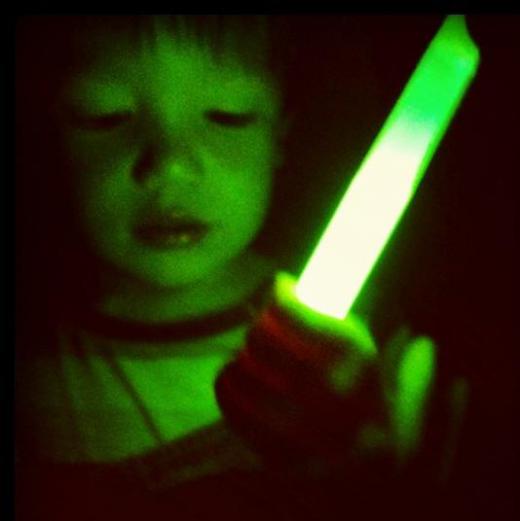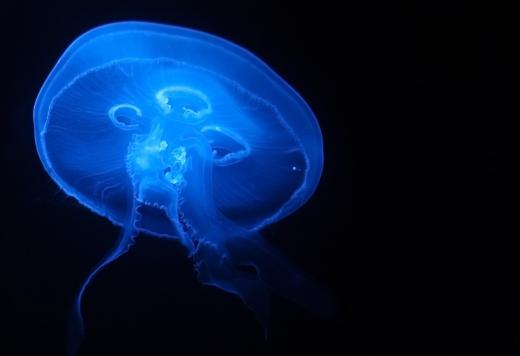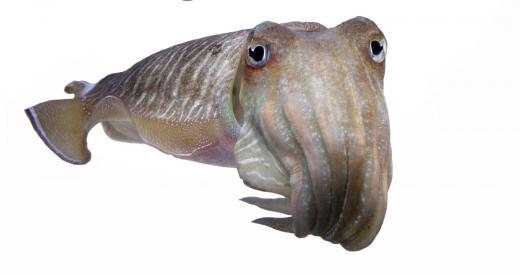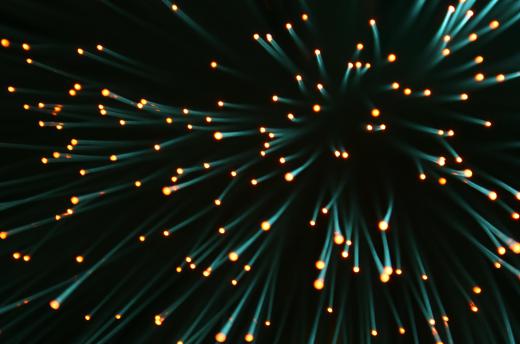How do Things Glow in the Dark?
Glowing in the dark, also called luminescence, usually is a simple matter of chemistry. Certain chemicals store energy when exposed to light, then slowly release that energy, which causes them to emit a small amount of light and thus glow. Other chemicals will react with each other, causing their electrons to become excited, and they will glow as those electrons release energy. Radioactive elements also can be used to make things glow. These three ways that things glow in the dark are known as phosphorescence, chemiluminescence and radioluminescence.
Examples

An object is said to glow in the dark when it emits light without being connected to a source of power, such as an electrical current or a battery, and without emitting more than a small amount of heat. A lit match, a flashlight bulb or a cellphone screen, for example, might emit light in the dark but would not be said to glow in the dark. The hands on a mechanical watch, toys, paints and novelty items are examples of things that sometimes glow in the dark.
Phosphorescence

The most common way of making an object glow in the dark is to use chemicals called phosphors to produce light. Objects that are coated with these chemicals need to be exposed to light before they can glow in the dark. The light energizes the phosphors and excites their electrons. As the electrons slowly lose this extra energy, the releasing of the energy creates light that usually is somewhat dim.

Scientists have created numerous phosphors in the lab, but zinc sulfide and strontium aluminate are the ones that are most commonly used in glow-in-the-dark products. Strontium aluminate is a newer technology, and its glow lasts longer. The chemicals often are mixed in with the plastic that is molded into a glow-in-the-dark object or is added to other material to create things such as glow-in-the-dark paint or makeup.
Chemiluminescence

Another way to make objects glow in the dark is through a chemical reaction. Two chemicals are mixed together, and the resulting reaction causes electrons to become excited and move to a higher energy level. As the electrons return to normal levels, they release energy, producing a glow. This is the type of reaction that is used to create the light in glow sticks.
Radioluminescence

Some items will glow without needing to be exposed to light, or "charged." These items still use phosphors to create the glow, but they add a radioactive element such as radium to the compound. The radioactive element gives off small amounts of radiation — not enough to be dangerous — that constantly charge the phosphors in the same way a light would. Radiation-charged phosphors typically are used on clock or watch hands that need to glow for hours after a light has been turned off — in case its owner needs to check the time in the middle of the night, for example.
Bioluminescence
Many living organisms are able to glow in the dark because of chemical reactions. Some contain all of the chemicals that they need to glow, and others will glow by a reaction to an element in its environment, such as oxygen. Fireflies, glow worms, creatures that live deep in the ocean and certain types of mushrooms are among the animals and plants that can glow. In some cases, such as with deep-sea creatures, bioluminescence is its only source of light. Other animals and plants glow for protection, camouflage, to attract mates or other reasons.
AS FEATURED ON:
AS FEATURED ON:















Discussion Comments
Does the light source affect the length of time a phosphorescent material will glow?
In UV light, what particular materials glow using this source of light?
Is there a limit on the light intensity that a luminescent material could produce? Will that be able to equal one candela?
I have clock, and its hands used to glow in dark. Over time it has stopped glowing at night, but there is still a green substance on the hour and minute hand. How can I fix it so it starts glowing at night again? I have tried placing it sunlight for hours but that doesn't work.
Why can't the phosphorous change in the light and not only in the dark or does that have to do with radiation too?
what substance can glow in the dark which has a long self life? for example a normal glow stick may last six hours, while a substance such as tritium stays lit for approx 10 years. are there any other substances that product long term light without needing en external energy source?
When you mix peroxide, baking soda and Mountain Dew, it glows in the dark.
The fluorescent tube glows because of the flow of electricity from the van de Graaff generator, through the tube, and into the ground through the teacher's hand. There are two possible reasons why it does not glow when held vertically:
1. The tube is too far away for the electricity to jump the gap
2. The electricity travels the least resistive path, which may be directly into the teacher's hand without traveling through the tube
Are these products safe? Is it fine to dress my kid in a pajama that glows in the dark?
who discovered that some things glow in the dark?
are there other alternatives to make things glow in the dark?
i would like to know why combined chemicals glow?
A van de Graaff generator is turned on and becomes fully charged. The teacher holds a fluorescent tube vertically nearby. Nothing happens. She then turns the tube so it is horizontal with one end close to the generator and the other far away. It begins to glow. Why?
Post your comments